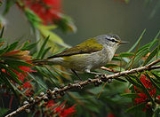
Tennessee Warbler
Encyclopedia
The Tennessee Warbler, Oreothlypis peregrina, is a New World warbler
. It breeds in northern North America
across Canada
and the northern USA. It is migratory
, wintering in southern Central America
and northern Colombia
and Venezuela
, with a few stragglers going as far south as Ecuador
. It is a very rare vagrant to western Europe
. This bird was named from a specimen collected in Tennessee
where it may appear during migration.
The Tennessee Warbler is 11.5 cm long and weighs 8.5 g. The breeding male is brown above and white below. The head is gray with a white supercilium and black eye stripe.
Females are duller, with a less contrasted head and yellow-tinged under-parts. Non-breeding and young birds are similar to the female, with first-winter birds being particularly yellow below.
The song is a series of musical notes and trills. The call is a sharp sit.
These birds feed on insect
s in summer, and numbers vary with the availability of Spruce Budworm
. In winter they will also eat berries and nectar.
The breeding habitat is coniferous or mixed woodland, especially spruce
. Tennessee Warblers nest on the ground, laying 4-7 eggs in a cup nest.
New World warbler
The New World warblers or wood-warblers are a group of small, often colorful, passerine birds restricted to the New World. They are not related to the Old World warblers or the Australian warblers....
. It breeds in northern North America
North America
North America is a continent wholly within the Northern Hemisphere and almost wholly within the Western Hemisphere. It is also considered a northern subcontinent of the Americas...
across Canada
Canada
Canada is a North American country consisting of ten provinces and three territories. Located in the northern part of the continent, it extends from the Atlantic Ocean in the east to the Pacific Ocean in the west, and northward into the Arctic Ocean...
and the northern USA. It is migratory
Bird migration
Bird migration is the regular seasonal journey undertaken by many species of birds. Bird movements include those made in response to changes in food availability, habitat or weather. Sometimes, journeys are not termed "true migration" because they are irregular or in only one direction...
, wintering in southern Central America
Central America
Central America is the central geographic region of the Americas. It is the southernmost, isthmian portion of the North American continent, which connects with South America on the southeast. When considered part of the unified continental model, it is considered a subcontinent...
and northern Colombia
Colombia
Colombia, officially the Republic of Colombia , is a unitary constitutional republic comprising thirty-two departments. The country is located in northwestern South America, bordered to the east by Venezuela and Brazil; to the south by Ecuador and Peru; to the north by the Caribbean Sea; to the...
and Venezuela
Venezuela
Venezuela , officially called the Bolivarian Republic of Venezuela , is a tropical country on the northern coast of South America. It borders Colombia to the west, Guyana to the east, and Brazil to the south...
, with a few stragglers going as far south as Ecuador
Ecuador
Ecuador , officially the Republic of Ecuador is a representative democratic republic in South America, bordered by Colombia on the north, Peru on the east and south, and by the Pacific Ocean to the west. It is one of only two countries in South America, along with Chile, that do not have a border...
. It is a very rare vagrant to western Europe
Europe
Europe is, by convention, one of the world's seven continents. Comprising the westernmost peninsula of Eurasia, Europe is generally 'divided' from Asia to its east by the watershed divides of the Ural and Caucasus Mountains, the Ural River, the Caspian and Black Seas, and the waterways connecting...
. This bird was named from a specimen collected in Tennessee
Tennessee
Tennessee is a U.S. state located in the Southeastern United States. It has a population of 6,346,105, making it the nation's 17th-largest state by population, and covers , making it the 36th-largest by total land area...
where it may appear during migration.
The Tennessee Warbler is 11.5 cm long and weighs 8.5 g. The breeding male is brown above and white below. The head is gray with a white supercilium and black eye stripe.
Females are duller, with a less contrasted head and yellow-tinged under-parts. Non-breeding and young birds are similar to the female, with first-winter birds being particularly yellow below.
The song is a series of musical notes and trills. The call is a sharp sit.
These birds feed on insect
Insect
Insects are a class of living creatures within the arthropods that have a chitinous exoskeleton, a three-part body , three pairs of jointed legs, compound eyes, and two antennae...
s in summer, and numbers vary with the availability of Spruce Budworm
Spruce Budworm
Spruce budworms and relatives are a group of closely related insects in the genus Choristoneura. Most are serious pests of conifers. There are nearly a dozen Choristoneura species, subspecies, or forms, with a complexity of variation among populations found throughout much of the United States and...
. In winter they will also eat berries and nectar.
The breeding habitat is coniferous or mixed woodland, especially spruce
Spruce
A spruce is a tree of the genus Picea , a genus of about 35 species of coniferous evergreen trees in the Family Pinaceae, found in the northern temperate and boreal regions of the earth. Spruces are large trees, from tall when mature, and can be distinguished by their whorled branches and conical...
. Tennessee Warblers nest on the ground, laying 4-7 eggs in a cup nest.
External links
- Tennessee Warbler Species Account - Cornell Lab of Ornithology
- Tennessee Warbler - Vermivora peregrina - USGS Patuxent Bird Identification InfoCenter
- Tennessee Warbler Information and Photos - South Dakota Birds and Birding

